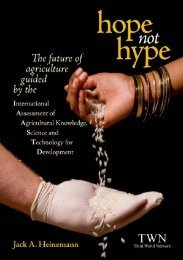gene Flow: Implications for Crop Diversity and Wild Relatives
gene Flow: Implications for Crop Diversity and Wild Relatives
gene Flow: Implications for Crop Diversity and Wild Relatives
- No tags were found...
You also want an ePaper? Increase the reach of your titles
YUMPU automatically turns print PDFs into web optimized ePapers that Google loves.
that introgression rates of <strong>gene</strong>s from one population to anothercan be quite rapid even when the fitness advantage is small(Barton & Dracup 2000), or when there is a high frequency oftransgressive hybrids (Reiseberg & Wendel 1993). A modellingstudy conducted by Haygood et al. (2003) demonstrated thatcrop alleles can be rapidly fixed in a recipient populationwhen the migration frequency exceeds the selection threshold,even when they have a negative impact on fitness. Their studyexp<strong>and</strong>s on how demographic swamping (reduced fitness in thehybrid’s offspring populations) can facilitate <strong>gene</strong>tic assimilationjust where high rates of <strong>gene</strong> flow occur from agriculturalpopulations. In this situation, <strong>gene</strong> flow that reduces fitnesswill become stable in the population when the migration rateof the alleles exceeds the level of selection, leading to reducedpopulation size <strong>and</strong> perhaps local extinction. Further, extinctionthrough hybridisation is a valid concern not only when itinvolves transgenic plants, but in any situation of non-nativebiological or <strong>gene</strong>tic invasions where hybridisation may increasea plant’s invasiveness (Ellstr<strong>and</strong> & Schierenbeck 2000).3.1 Types of trans<strong>gene</strong> flows <strong>and</strong> theirimplicationsWith the now decade-long history of GMO commercialisation,the world has already witnessed a number of cases oftrans<strong>gene</strong> flow, from crop to wild relatives, crop to l<strong>and</strong>race<strong>and</strong> crop to crop. Within each type of trans<strong>gene</strong> flow, a hostof environmental, agronomic, cultural, <strong>and</strong> intellectual propertyconcerns emerge in conjunction with the biological <strong>and</strong>evolutionary considerations of <strong>gene</strong> flow. While research hasmade some progress, there is still much to be learned.11
















